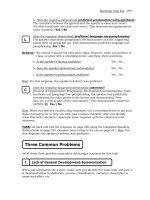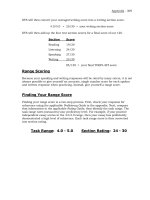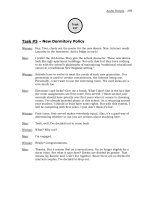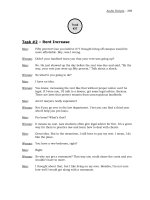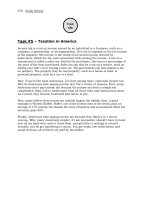Making Connections between Speaking and Writing
Bạn đang xem bản rút gọn của tài liệu. Xem và tải ngay bản đầy đủ của tài liệu tại đây (125.9 KB, 4 trang )
Gen1.5MakingConnectionsbetween
Speaking and Writing
4/5/08
Copywrite vanDommelen2008 1
TESOL 2008 April 5, 2008
Generation 1.5: Making Connections
between Speaking and Writing
Deborah vanDommelen
San Francisco State University
/>Generation 1.5 Learners at San Francisco
State Learning Assistance Center
• are generally orally proficient;
• communicate in English with ease and facility;
• have acquired English in ways similar to
native speakers;
• have trouble learning and applying
grammatical rules;
• struggle with conventions of academic
English.
Assessing Practices; Developing an Approach;
Working with Orally Fluent Multilingual Learners
1. Acknowledge and draw upon students’ strengths as
oral communicators.
2. Develop activities that help students discover
learning preferences: oral, aural, written.
3. Guide students in making connections between how
they speak and how they write.
4. Help students raise awareness about the
connection between spoken language and written
discourse.
Activity 1. Warm-Up: Comparing Language
Backgrounds and Ways of Learning
mimicking teachersSpanglishMarlena
in pre-school:
reading/writing
EnglishMichael
home; communityEbonicsJade
at homeTagalogLarissa
from cousins, schoolChineseAlvin
How/when did you
learn English?
First
language
you learned?
Name
Activity 2. Writing Comparing Learning in the
Aural Mode with Learning in the Written Mode
Directions
1. With a partner, use the information from the
introductory activity about how you learned
English to come up with two definitions: one
for “eye learner” and the other for “ear
learner.” Write your definitions on the board.
2. As a large group, discuss the different ideas
on the board to decide on two definitions
that work for the class.
Activity 2. Writing Comparing Learning in the
Aural Mode with Learning in the Written Mode
Directions
3. With your partner, interview each other
using the following question: “Are you an
‘eye-learner’ or ‘ear-learner’ of English?
Ask your partner to explain why. Take
notes.
4. For homework (on paper or OH
transparencies), write a summary of your
interview.
Gen1.5MakingConnectionsbetween
Speaking and Writing
4/5/08
Copywrite vanDommelen2008 2
“Fernando learns better by eye learning. He
said that with ear learning only he easily gets
bored, but with eye learning, he learns more.
He noticed he was a better learner by certain
types of eye learning when he was 14 years old,
when he read a book and understood nothing,
but when he watched a movie and listened to
the characters, he understood it all.”
“Loan is an eye and ear learner that uses both
of her learning experiences to learn more. She
uses both most of the time, but she can adopt
any of the learning techniques depending on
the situations. She said that for chemistry she
uses both and for grammar only uses eye
learning. She realize that she uses both last
night whe she answer the homework question.”
Activity 3. Dictocomp: Listening, reconstructing
text, negotiating meaning and form
• Students listen to a text read two or more
times by the teacher;
• take notes on key words as they listen;
• work in pairs or small groups to negotiate
meaning and form;
• reconstruct their own text based on the notes
they have taken. (Wajnryb, 1990)
Activity 3. Dictocomp: Listening, reconstructing
text, negotiating meaning and form
The dictocomp text can be
• a piece of student writing
• an excerpt from a reading
• a brief paragraph constructed by the teacher
The text the students produce
• conveys the meaning of the original
• is not necessarily identical (as in a dictation)
Activity 3. Dictocomp: Listening, reconstructing
text, negotiating meaning and form
1. The teacher reads the whole text through at
a normal pace, pausing slightly between
sentences. Students don’t write.
2. The teacher re-reads the text at a normal
pace, pausing briefly between clauses.
Students take notes.
3. Students in pairs, triads, or small groups,
compare notes to reconstruct the text.
Groups can write on the board, on overhead
transparencies, or at their desks.
Activity 3. Dictocomp: Listening, reconstructing
text,negotiating meaning and form
4. After reconstructing their texts, students apply
their active editing strategies, negotiate form
and meaning, and revise and correct their work.
5. As a class, compare different versions,
examining the relationship between form and
meaning, between spoken word and written
text. Students look for evidence of oral forms
or patterns in their written work: dropped
endings, missing subjects, missing time
expressions, or joining words.
Gen1.5MakingConnectionsbetween
Speaking and Writing
4/5/08
Copywrite vanDommelen2008 3
I interviewed Don yesterday about what it
means to be either an ear learner or an eye learner.
He has some interesting ideas about this topic,
mostly because he speaks two different languages
that he learned in two different ways. For his first
language, he speaks Cambodian, and he has been
learning this language at home since he was a baby.
From learning a language as a child, he understands
that you listen, imitate, and repeat what others say.
Learning Cambodian made him an ear learner.Yet he
also learned English when he was in grade school.
He learned by reading, which requires seeing then
writing, and by memorizing, which requires studying
worksheets and reading notes. Learning English has
made him an eye learner as well as an ear learner.
Activity 4. Oral-Written Project
• raises students’ awareness of differences
between spoken and written English;
(modified: Kutz, Groden, and Zamel, 1993)
• builds explicitly on students’ competence as
oral language users in order to develop their
confidence with written academic English;
• engages students in a study of spoken and
written communication: students discover
how what they know and do as speakers links
to what is required of writers communicating
to an academic audience.
Activity 4. Oral-Written Project
Students
1. tell a story into a tape recorder and prepare
transcriptions;
2. write the same story;
3. prepare a four-six page written comparative
analysis of the written and oral story;
4. write a self-reflection about what they have
learned from telling a story, writing a story,
and writing a report for an academic
audience.
“Many times idea just seem to come out, when telling
or writing a story, but it is hard to prepare them to form
sentences. In my oral, I was so lost, I did not know
where to begin and had so many things going on in
my head at once. I laughed and giggled a lot and used
to interact with my audience. I tried to make eye
contact to see if they were paying attention or if they
were rolling their eyes at me or having a strange look.
It was a lot harder to interact with my reader, but I had
time to plan out what I was going to say and I was not
scared because I could stop and go back to it when I
remembered what was going; which I could not do in
my oral.”
Activity 4. Oral-Written Project: Outcomes
Students
• show an awareness of needs of audience in
oral communication;
• reveal what they know about the unplanned
nature of spoken language; how repairs and
revisions are made on the spot;
• realize that writing requires sustained
planning and revision; that they need to
anticipate audience needs;
• compare oral competence with emerging
understanding of what is required in written
academic discourse.
Acknowledgments
Patricia Porter
Jennifer Peters
Sugie Goen-Salter
San Francisco State University
Gen1.5MakingConnectionsbetween
Speaking and Writing
4/5/08
Copywrite vanDommelen2008 4
References
Destandau, Nathalie & Wald, Margi (2002). Promoting
Generation 1.5 learners’ academic autonomy:
Contributions from the learning center. CATESOL
Journal, 14.1, 207-234.
Goen, S., Porter, P., Swanson, D., & vanDommelen, D.
(2002). Working with generation 1.5 students and
their teachers: ESL meets composition. CATESOL
Journal 14, 131-171.
Goen-Salter, S., Porter P., & vanDommelen D.(in
press). Pedagogical principles and practices for
working With generation 1.5. In Roberge, M., M.
Siegal, and L. Harklau (Eds.). Generation 1.5 in
College Composition. New York: Taylor & Frances
Publishers.
References
Porter, P. & vanDommelen, D. (2005). Read, write,
edit: Grammar for college writers. Boston: Thomson
Heinle.
Kutz, E., Groden, S.Q., & Zamel, V. (1993). The
discovery of competence: Teaching and learning
with diverse student writers. Portsmouth, NH:
Boynton/Cook.
Wajnryb, R. (199). Grammar dictation. Oxford,
England: Oxford University Press.
